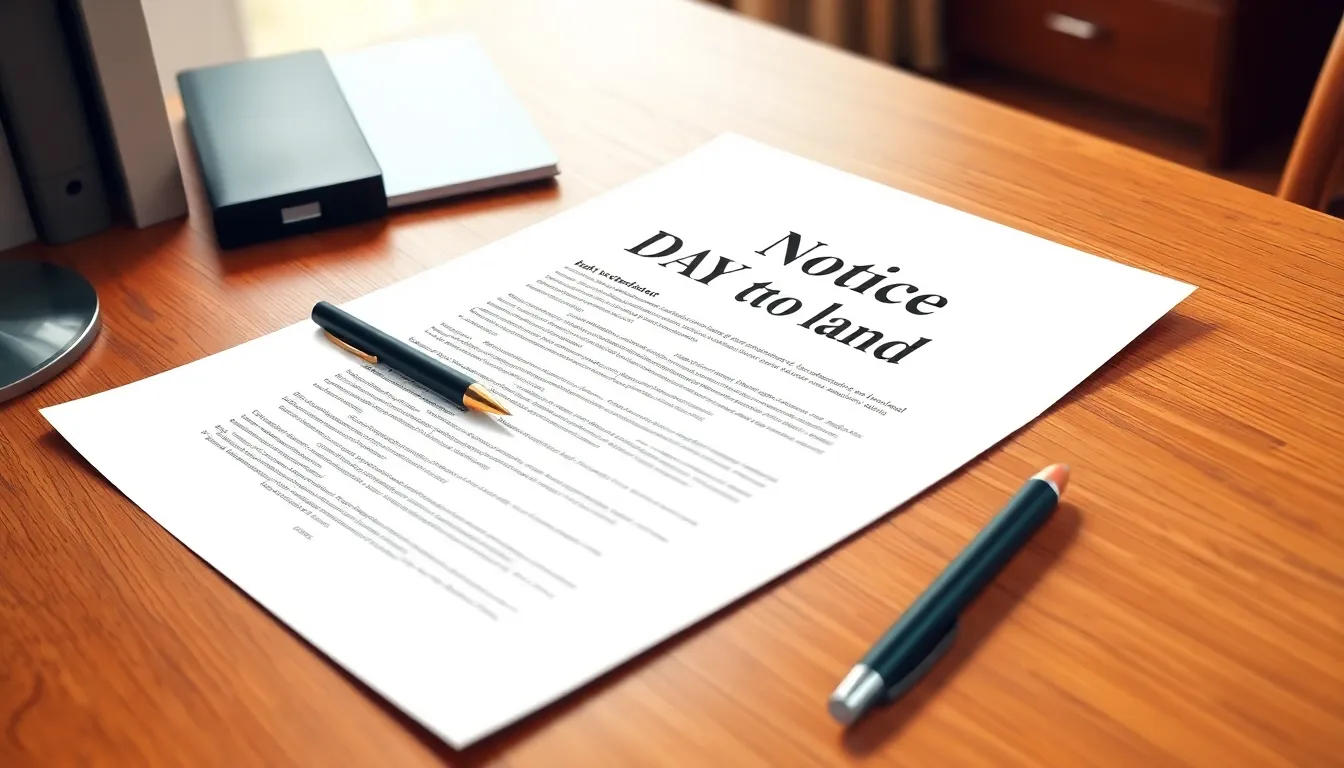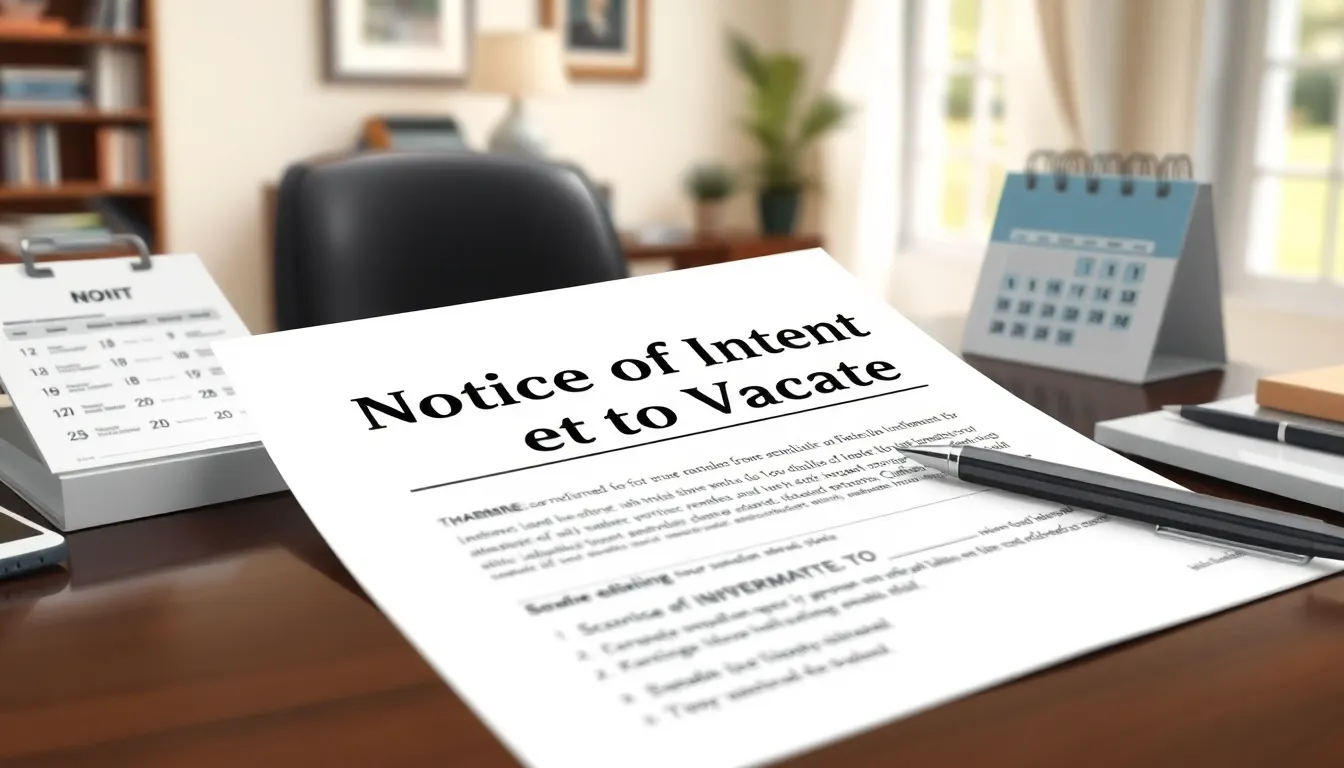Table of Contents
ToggleMoving out can feel like a monumental task, but it doesn’t have to be a headache. When the time comes to bid farewell to a rental, a simple 30-day notice to the landlord is all it takes to kick off your next adventure. Think of it as your ticket to freedom—no more late-night landlord visits or awkward run-ins at the mailbox.
Understanding a Simple 30 Day Notice to Landlord
A simple 30-day notice to the landlord serves as a crucial step in the moving process. This formal notification allows tenants to leave a rental property without future obligations.
Importance of Giving Notice
Providing notice holds significant importance in the rental process. It establishes a record of intent to vacate, which can protect tenants from disputes. Timely written notifications help landlords prepare for new tenants, ensuring a smoother transition. Clarity in communication minimizes misunderstandings and positively impacts tenant-landlord relationships. Respecting lease agreements by notifying landlords shows responsibility, paving the way for future references.
When to Use a 30 Day Notice
Using a 30-day notice applies primarily when tenants decide to move out. Typically, this notice aligns with the end of a lease term or after a mutual agreement with the landlord. Early issuance of the notice ensures all parties are aware of the tenant’s intentions. It prevents confusion, especially if the landlord requires time to find a replacement tenant. Legal stipulations often mandate providing this notice, making it essential to comply with rental agreements and state laws.
Components of a Simple 30 Day Notice


A simple 30-day notice to the landlord contains essential details that communicate the tenant’s intent to vacate. Clarity and completeness are crucial in this document to avoid misunderstandings.
Essential Information to Include
Include the tenant’s name and address at the top. Indicate the landlord’s name and address directly below. Specify the desired move-out date, ensuring it’s at least 30 days from the notice date. Mention the reason for leaving, though this is optional. Clearly state a request for a final walkthrough to allow for the return of the security deposit. Signing the notice adds authenticity and commitment to the intent presented.
Formatting Your Notice
Format the notice in a professional manner. Use a standard business letter format for clarity. Start with a date followed by the landlord’s contact information. Utilize clear headings for sections such as “Notice of Intent to Vacate.” Keep paragraphs short and to the point to enhance readability. Remember to print the notice on clean paper and consider delivering it in person or via certified mail for tracking purposes. Each detail contributes to a more effective notice.
Tips for Writing an Effective Notice
Writing an effective notice ensures clear communication between tenants and landlords. Focusing on essential details helps avoid misunderstandings during the moving process.
Be Clear and Concise
Clarity simplifies understanding. Include the tenant’s and landlord’s names in the notice. Clearly state the intended move-out date, specifying that it should be at least 30 days after the notice date. Avoid using excessive language, as brevity captures attention. Listing a reason for moving out can provide context, but it remains optional. Ensure that these key points stand out, giving landlords the necessary information without confusion. A straightforward approach helps both parties reach a mutual understanding.
Use a Professional Tone
Maintaining professionalism reflects seriousness. Formatting the notice like a business letter establishes credibility. Start with a proper greeting and conclude with a polite closing. An authoritative tone avoids misunderstandings and shows respect. Avoid casual language, as it may undermine the notice’s significance. Using a professional tone builds a positive interaction, potentially leading to better references in the future. Committing to this level of professionalism reinforces the tenant’s intent to honor the lease agreement.
Sending Your Notice
Sending a notice to a landlord marks a significant step in the moving process. Clarity and professionalism play vital roles in this communication.
Delivery Methods
Choose a method that ensures confirmation of delivery. Hand-delivering the notice provides immediate acknowledgment. Alternatively, sending it via certified mail offers a reliable way to track delivery. In some cases, an email may be acceptable if the lease terms allow this method. Verify the requirements beforehand to avoid pitfalls. Each method possesses unique advantages, so opt for one that aligns with personal preferences and situations.
Keeping a Record
Maintaining a copy of the notice protects tenants against potential disputes. Store a copy in a designated folder for easy access in the future. Document any communication related to the notice to ensure clear records. Capturing the date of delivery is crucial for confirming compliance with the 30-day requirement. When applicable, request a written acknowledgment from the landlord as added assurance. Each step in this process safeguards the tenant’s rights, providing peace of mind during the transition.








